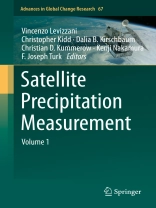This book offers a complete overview of the measurement of precipitation from space, which has made considerable advancements during the last two decades. This is mainly due to the Tropical Rainfall Measuring Mission (TRMM), the Global Precipitation Measurement (GPM) mission, Cloud Sat and a carefully maintained constellation of satellites hosting passive microwave sensors. The book revisits a previous book, Measuring Precipitation from Space, edited by V. Levizzani, P. Bauer and F. J. Turk, published with Springer in 2007. The current content has been completely renewed to incorporate the advancements of science and technology in the field since then. This book provides unique contributions from field experts and from the International Precipitation Working Group (IPWG).
The book will be of interest to meteorologists, hydrologists, climatologists, water management authorities, students at various levels and many other parties interested in making use of satellite precipitation data sets.Chapter “TAMSAT” is available open access under a Creative Commons Attribution 4.0 International License via link.springer.com.
Table of Content
SECTION 1 Status of Observations and Satellite Programs: Chapter 1. The Global Precipitation Measurement (GPM) mission.- Chapter 2. Status of the Cloud Sat mission.- Chapter 3. The Megha-Tropiques mission after seven years in space.- Chapter 4. Microwave sensors, imagers and sounders.- Chapter 5. Microwave and sub-mm wave sensors: A European perspective.- Chapter 6. Plans for future missions.- SECTION 2 Retrieval Techniques, Algorithms and Sensors: Chapter 7. Introduction to passive microwave retrieval methods.- Chapter 8. The Goddard Profiling (GPROF) precipitation retrieval algorithm.- Chapter 9. Precipitation estimation from the Microwave Integrated Retrieval System (Mi RS).- Chapter 10. Introduction to radar rain retrieval methods.- Chapter 11. Dual-frequency Precipitation Radar (DPR) on the Global Precipitation Measurements (GPM) mission’s Core Observatory.- Chapter 12. DPR dual-frequency precipitation classification.- Chapter 13. Triple-frequency radar retrievals.- Chapter 14. Precipitation retrievals from satellite combined radar and radiometer observations.- Chapter 15. Scattering of hydrometeors.- Chapter 16. Radar snowfall measurement.- Chapter 17. A 1DVar-based snowfall rate algorithm for passive microwave radiometers.- Chapter 18. X-band synthetic aperture radar methods.- SECTION 3 Merged Precipitation Products: Chapter 19. Integrated Multi-satellit E Retrievals for the Global Precipitation Measurement (GPM) mission (IMERG).- Chapter 20. Global Satellite Mapping of Precipitation (GSMa P) products in the GPM era.- Chapter 21. Improving PERSIANN-CCS using passive microwave rainfall estimation.- Chapter 22. TAMSAT.- Chapter 23. Algorithm and data improvements for version 2.1 of the Climate Hazards Center’s Infrared Precipitation with Stations Data Set.- Chapter 24. Merging the infrared fleet and the microwave constellation for tropical hydrometeorology (TAPEER) and global climate monitoring (GIRAFE) applications.- SECTION 4 Validation: Chapter 25. The IPWG satellite precipitation validation effort.- Chapter 26. The GPM Ground Validation Program.- Chapter 27. The GPM DPR Validation Program.- Chapter 28. Error and uncertainty characterization.- Chapter 29. Multiscale evaluation of satellite precipitation products: Effective resolution of IMERG.- Chapter 30. Remote sensing of orographic precipitation.- Chapter 31. Integrated multi-satellite evaluation for the Global Precipitation Measurement: Impact of precipitation types on spaceborne precipitation estimation.- Chapter 32. Hydrologic validation and flood analysis.- Chapter 33. Global-scale evaluation of 22 precipitation datasets using gauge observations and hydrological modeling.- Chapter 34. Ocean RAIN – The global ocean surface-reference dataset for characterization, validation and evaluation of the water cycle.- SECTION 5 Observed Characteristics of Precipitation: Chapter 35. GPCP and the global characteristics of precipitation.- Chapter 36. Global snowfall detection and measurement.- Chapter 37. Snowfall detection by spaceborne radars.- Chapter 38. On the duration and lifecyle of precipitation systems in the tropics.- Chapter 39. Observational characteristics of warm-type heavy rainfall.- Chapter 40. Satellite precipitation measurement and extreme rainfall.- Chapter 41. Rainfall trends in East Africa from an ensemble of IR-based satellite products.- Chapter 42. Heavy precipitation systems in the Mediterranean area: The role of GPM.- Chapter 43. Dryland precipitation climatology from satellite observations.- Chapter 44. Haifall detection.- Chapter 45. Improving high-latitude and cold region precipitation analysis.- Chapter 46. Latent heating retrievals from satellite observations.- SECTION 6 Applications: Chapter 47. Operational applications of Global Precipitation Measurement observations.- Chapter 48. Assimilation of precipitation observations from space into numerical weather prediction (NWP).- Chapter 49. Precipitation ensemble data assimilation in NWP models.- Chapter 50. PERSIANN-CDR for hydrology and hydro-climatic applications.- Chapter 51. Soil moisture and precipitation: The SM2RAIN algorithm for rainfall retrieval from satellite soil moisture.- Chapter 52. Drought risk management using satellite-based rainfall estimates.- Chapter 53. Two decades of urban hydroclimatological studies have yielded discovery and societal benefits.- Chapter 54. Validation of climate models.- Chapter 55. Extreme precipitation in the Himalayan landslide hotspot.- Chapter 56. The value of satellite rainfall estimates in agriculture and food security.- Chapter 57. Using satellite estimates of precipitation for fire danger rating.- Chapter 58. Variability of satellite sea surface salinity under rainfall.












